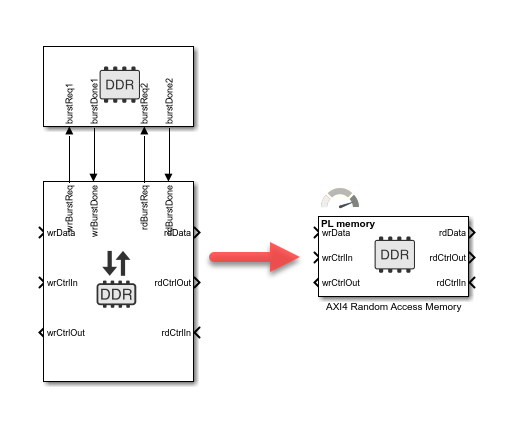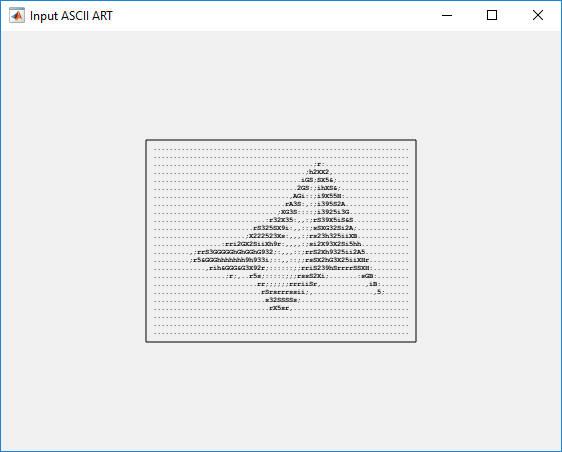AXI4 Random Access Memory
Libraries:
SoC Blockset /
Memory
Description
The AXI4 Random Access Memory block models a connection between two hardware algorithms through external memory, using the MathWorks® simplified AXI4 manager protocol. Both the writer and the reader are managers, sending read and write requests to memory through the block. The external memory is unmanaged (no logical buffers, no circular buffer). To ensure the integrity of the data, the reader and writer coordinate timing on accesses.
This block is equivalent to a Memory Channel block with the
Channel type parameter set to AXI4 Random
Access connected to a Memory Controller block.
Since the memory controller is implicit to the design - you can instantiate several memory blocks that connect to the same memory unit via a memory controller. Valid blocks are:
The maximum number of manager interfaces in a model is 16.

For more information, see Simplified AXI4 Master Interface.
Examples
Random Access of External Memory
Model external memory accesses from FPGA for rotating an ASCII art image. Many applications require FPGA to access memory in random fashion as per the requirements of algorithm. You will learn how to design memory address generation along with other AXI4 master signals to read and write specific regions of memory using SoC Blockset. You will simulate, implement and verify your design on hardware.
Ports
Input
This signal contains the data to the memory.
Data Types: single | double | int8 | int16 | int32 | int64 | uint8 | uint16 | uint32 | uint64 | Boolean | fixed point
This port accepts a control bus from a data consumer block, signaling that the consumer block is ready to accept read data. This input is a read-request from the reader. To create the control bust, use the SoC Bus Creator block.
Data Types: ReadControlM2SBusObj
This port accepts a control bus from a data producer block, signaling that the producer block is ready to send data. This input is a write-request from the writer. To create the control bus, use the SoC Bus Creator block.
Data Types: WriteControlM2SBusObj
Output
This signal contains the data read from the memory.
Data Types: single | double | int8 | int16 | int32 | int64 | uint8 | uint16 | uint32 | uint64 | Boolean | fixed point
This bus represents the protocol bus from the memory channel to the data consumer. To separate the signal from the bus, use the SoC Bus Selector block.
Data Types: ReadControlS2MBusObj
This bus represents the protocol bus from the memory channel to the data producer. To separate the signal from the bus, use the SoC Bus Selector block.
Data Types: WriteControlS2MBusObj
Parameters
Memory simulation provides two levels of timing resolution. Select one of these options:
Burst accurate — Simulates memory contention and high-resolution timing.
Protocol accurate — Simulates AXI4 protocol hand-shaking sequencing and low-resolution timing.
Main
Select between processing subsystem (PS) or programming logic (PL) memory.
If the selected board supports only a PL memory, then the default value is
PL memory.If the selected board supports only PS memory or only PL memory, then this parameter is read-only.
If the selected board is not a supported SoC board, then this parameter is not visible.
Specify the size of the memory buffer in bytes.
Select this parameter to enable presimulation memory initialization.
Specify an initial value for memory simulation, as one of the following:
Integer scalar value between 0–255 — The block replicates and loads this value to all memory locations.
Vector of
uint8— The block writes each element of the vector into a memory location.If the vector is smaller than the memory region, the vector is padded with zeroes to match the size of the memory region.
If the vector is larger than the memory region, the vector is truncated to match the size of the memory region.
Example: 0 — Initializes all memory locations with
zeros.
Example: 1:10 — Initializes the first ten memory locations with
values 1–10 and the other locations with zeros.
Dependencies
To enable this parameter, select Initialize memory.
Select this parameter to enable postsimulation memory logging.
Name of variable to hold the data of the memory content, specified as a string or character vector.
Example: 'mem_content'
Dependencies
To enable this parameter, select Log memory ending value.
Signal Attributes
Write data signal
wrData can be a multidimensional array. Specify the dimension for the array as a whole number.
Example: 1 — A scalar sample.
Example: [10 1] — A vector of ten scalars.
Example: [1080 1920 3] — A 1080p frame. The frame includes 1080 lines of 1920 pixels per line, and each pixel is represented by three values (for red, green, and blue).
Specify the data type of the wrData port. For help, click the ... button and select Data Type Assistant.
Specify a time interval in seconds to define how often the block updates.
When you do not want the output to have a time offset, specify the
Sample time parameter as a scalar. To add a time offset to
the output, specify the Sample time parameter as a
1-by-2 vector, where the first element is the
sampling period and the second element is the offset. For more information about
sample times in Simulink®, see Specify Sample Time.
Select this parameter to enable data packing across the last dimension of the
signal. The AXI4-Random Access Memory block packs the data along the
last dimension of the signal. For example, if the channel data type is
uint32, the dimensions are [1024 4]. If you
select this sample packing parameter, then the memory channel generates 1024 read or
write transactions of 128 bits. If you clear this sample packing parameter, the memory
channel generates 4096 transactions of 32 bits each.
This figure shows how data is aligned for a signal with data type
fixdt10[4x3]. When the data is packed, three 10-bit words are
concatenated and extended by 2 bits to a 32-bit word. When the data is not packed,
each 10-bit word is extended to a 16-bit word.

This figure shows how data is aligned for a signal with data type
uint8[8x3]. When the data is packed, three 8-bit words are
concatenated and extended by 8 bits to a 32-bit word. When the data is not packed,
each 8-bit word is represented as an 8-bit sample.

The combined width of the flattened signal must not exceed 512 bits.
Read data signal
Select this box to use the same dimensions and data type for the reader and the writer of this channel. Clear the box to customize different dimensions and data type for the reader and writer interfaces.
rdData can be a multidimensional array. Specify the dimension for the array as a whole number.
Example: 1 — A scalar sample.
Example: [10 1] — A vector of ten scalars.
Example: [1080 1920 3] — A 1080p frame. The frame includes 1080 lines of 1920 pixels per line, and each pixel is represented by three values (for red, green, and blue).
Specify the data type of the rdData port. For help, click the ... button and select Data Type Assistant.
Dependencies
To enable this parameter, clear the Output data signal matches input check box.
Specify a time interval in seconds to define how often the block updates.
When you do not want the output to have a time offset, specify the
Sample time parameter as a scalar. To add a time offset to
the output, specify the Sample time parameter as a
1-by-2 vector, where the first element is the
sampling period and the second element is the offset. For more information about
sample times in Simulink, see Specify Sample Time.
Dependencies
To enable this parameter, clear the Output data signal matches input check box.
Select this parameter to enable data packing across the last dimension of the
signal. The AXI4 Random Access Memory block packs the data along the
last dimension of the signal. For example, if the channel data type is
uint32, the dimensions are [1024 4]. If you
select this sample packing parameter, then the memory channel generates 1024 read or
write transactions of 128 bits. If you clear this sample packing parameter, the memory
channel generates 4096 transactions of 32 bits each.
This figure shows how data is aligned for a signal with data type
fixdt10[4x3]. When the data is packed, three 10-bit words are
concatenated and extended by 2 bits to a 32-bit word. When the data is not packed,
each 10-bit word is extended to a 16-bit word.

This figure shows how data is aligned for a signal with data type
uint8[8x3]. When the data is packed, three 8-bit words are
concatenated and extended by 8 bits to a 32-bit word. When the data is not packed,
each 8-bit word is represented as an 8-bit sample.

The combined width of the flattened signal must not exceed 512 bits.
Dependencies
To enable this parameter, clear the Output data signal matches input check box.
Performance
Clicking the button opens the Performance Plots for Memory Controller window. You can then select to plot bandwidth, bursts, or latencies. For more information about performance graphs, see Memory Controller Latency Plots.
Dependencies
To enable this parameter, select Burst accurate under Memory simulation.
Extended Capabilities
HDL Code Generation
Generate VHDL, Verilog and SystemVerilog code for FPGA and ASIC designs using HDL Coder™.
Fixed-Point Conversion
Design and simulate fixed-point systems using Fixed-Point Designer™.
Version History
Introduced in R2022bYou can now load an initial value before simulation or log memory content after simulation.
To initialize the memory, open the block mask and select Initialize memory in the main tab. Then, specify the initial value in the Initial value box.
To log the contents of the memory after simulation, open the block mask and select Log memory ending value in the main tab. Then, specify the initial value in the Initial value box.
In previous releases, you can specify the size of the memory region in the Buffer size box, and that was reflected as a read-only Region size parameter. In R2023a, specify that size in the Region size (bytes) parameter.
MATLAB Command
You clicked a link that corresponds to this MATLAB command:
Run the command by entering it in the MATLAB Command Window. Web browsers do not support MATLAB commands.
选择网站
选择网站以获取翻译的可用内容,以及查看当地活动和优惠。根据您的位置,我们建议您选择:。
您也可以从以下列表中选择网站:
如何获得最佳网站性能
选择中国网站(中文或英文)以获得最佳网站性能。其他 MathWorks 国家/地区网站并未针对您所在位置的访问进行优化。
美洲
- América Latina (Español)
- Canada (English)
- United States (English)
欧洲
- Belgium (English)
- Denmark (English)
- Deutschland (Deutsch)
- España (Español)
- Finland (English)
- France (Français)
- Ireland (English)
- Italia (Italiano)
- Luxembourg (English)
- Netherlands (English)
- Norway (English)
- Österreich (Deutsch)
- Portugal (English)
- Sweden (English)
- Switzerland
- United Kingdom (English)
